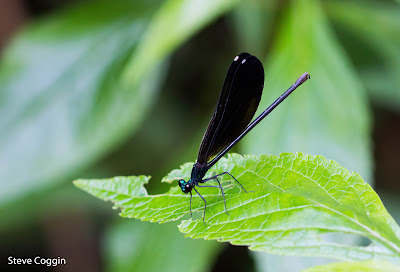 |
| Red-cockaded Woodpecker (Dryobates borealis) at a nest hole in a Longleaf Pine (Pinus palustris). Weymouth Woods Sandhills Nature Preserve, North Carolina. |
Longleaf Pines (Pinus palustris) tower over drought tolerant plants that grow from the sandy soil. Threatened Red-cockaded Woodpeckers (Dryobates borealis) fly between the trees. This is the Weymouth Woods Sandhills Nature Preserve, located in Moore County North Carolina. The Sandhills run along the inland edge of the Coastal Plain from Georgia to Virginia. They are the remains of ancient windblown dunes and sand sheets formed when sea levels were higher than today. The rainwater drains quickly through the sand creating a home for a unique assemblage of plants and animals.
 |
| Longleaf Pines. Weymouth Woods Sandhills Nature Preserve, North Carolina. |
 |
| Longleaf Pine forest. The trees have been scorched by fire at their bases. Weymouth Woods Sandhills Nature Preserve, North Carolina. |
 |
| Yellow Wild Indigo (Baptisia tinctoria). Weymouth Woods Sandhills Nature Preserve, North Carolina. |
 |
| Goat's Rue (Tephrosia virginiana). Weymouth Woods Sandhills Nature Preserve North Carolina. |
 |
| Spurge Nettle (Cnidoscolus stimulosus). Weymouth Woods Sandhills Nature Preserve, North Carolina. |
 |
| Maryland Meadow Beauty (Rhexia mariana). Weymouth Woods Sandhills Nature Preserve, North Carolina. |
 |
| Rattlesnake Master (Eryngium yuccifolium). Weymouth Woods Sandhills Nature Preserve, North Carolina. |
 |
| Threadleaf Coreopsis (Coreopsis verticillata). Weymouth Woods Sandhills Nature Preserve, North Carolina. |
 |
| White-topped Aster (Sericocarpus sp.). Weymouth Woods Sandhills Nature Preserve, North Carolina. |
Composites (family Asteraceae) like the impressive Rattlesnake Master (Eryngium yuccifolium), yellow flowered Threadleaf Coreopsis (Coreopsis vericillata) and the delicate White-topped Aster (Seriococarpus sp.) brighten up the woods.
 |
| James Creek. Weymouth Woods Sandhills Nature Preserve, North Carolina. |
 |
| Sweet Bay Magnolia (Magnolia virginiana). Weymouth Woods Sandhills Nature Preserve, North Carolina. |
 |
| Ebony Jewelwing (Calopteryx maculata). The white spots on the tips of the wing show this is a female Ebony Jewelwing. Weymouth Woods Sandhills Nature Preserve, North Carolina. |
James Creek trickles through Weymouth Woods and the trail crosses this small stream in several places. The creek supports an array of plants that require more water, like Sweetbay Magnolia (Magnolia virginiana). Ebony Jewelwings (Calopteryx maculata), brilliant black and blue damselflies flutter in the cool shade.
 |
| Cottonmouth (Agkistridon piscivorus) swimming across James Creek. Weymouth Woods Sandhills Nature Preserve, North Carolina. |
The creek also harbors Cottonmouths, also known as Water Moccasins (Akistrodon piscivorus), a venomous pit viper. In fact, one of the bridges across James Creek is called Moccasin Crossing. One day Diane and I were hiking along the creek and happened upon one of these snakes. We jumped back in surprise as the snake slid into the water and swam away.
 |
| This female Eastern Towhee (Piplio erythrophthalmus) is a member of the white-eyed subspecies. Weymouth Woods Sandhills Nature Preserve, North Carolina. |
 |
| A brilliant male Summer Tanager (Piranga rubra) peeking around a branch. Weymouth Woods Sandhills Nature Preserve, North Carolina. |
 |
| This Great-crested Flycatcher (Myiarchus crinitus) was carrying a feather to its nest hole. Weymouth Woods Sandhills Nature Preserve, North Carolina. |
 |
| Eastern Wood Pewee (Contopus virens). Weymouth Woods Sandhills Nature Preserve, North Carolina. |
Birds are abundant in the pine forest and along the creek. White-eyed Eastern Towhees (Pipilo erythrophthalmus) call from the undergrowth. The Sandhills are the inland limit of this Coastal Plain subspecies's range. Summer Tanagers (Piranga rubra) give their “pit-i-tuck” call from the trees, Great-crested Flycatchers (Myiarchus crinitus) pop in and out of their nest holes and Eastern Wood Pewees (Contopus virens) sing their plaintive “pee-oh-wee” song as they look for insects.
 |
| Common Nighthawk (Chordeiles minor). Weymouth Woods Sandhills Nature Preserve, North Carolina. |
Common Nighthawks (Chordeiles minor) usually hunt at night but will sometimes fly during the day. We were lucky enough to see them perform their impressive aerial mating display. A male Nighthawk will climb to an impressive height than swoop toward the ground. As it dives, air passing through wing feathers makes a roar like a speeding racecar. This is known as booming and is done to attract female Nighthawks and to warn off trespassing males.
 |
| Bachman's Sparrow (Peucaea aestivalis). Weymouth Woods Sandhills Nature Preserve, North Carolina. |
 |
| Red-headed Woodpecker (Melanerpes erythrocephalus). Weymouth Woods Sandhills Nature Preserve, North Carolina. |
 |
| Red-cockaded Woodpecker. Weymouth Woods Sandhills Nature Preserve, North Carolina. |
 |
| Red-cockaded Woodpecker visiting its nest hole. Weymouth Woods Sandhills Nature Preserve, North Carolina. |
 |
| Red-cockaded Woodpecker flying from its nest hole. Weymouth Woods Sandhills Nature Preserve, North Carolina. |
 |
| Red-cockaded Woodpecker nest tree. Dripping sap stains the tree white around the nest hole. Weymouth Woods Sandhills Nature Preserve, North Carolina. |

No comments:
Post a Comment